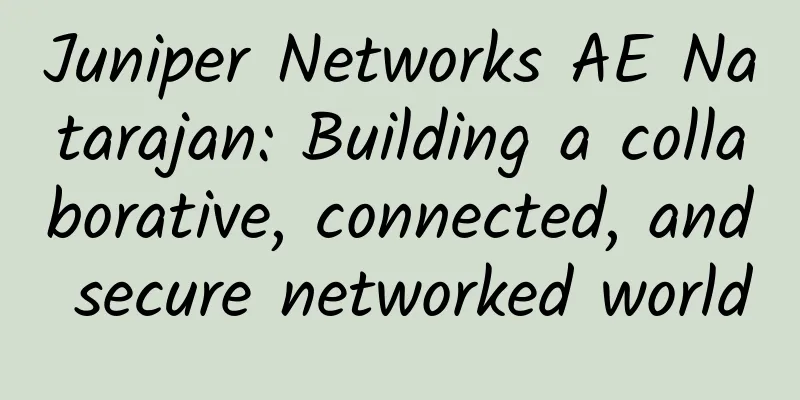Juniper Networks AE Natarajan: Building a collaborative, connected, and secure networked world

|
[51CTO.com original article] The early winter of 2018 came a little early. Juniper Networks has already turned on the heating in its office area in Beijing. AE Natarajan, senior vice president of global engineering, who came from the United States, accepted an interview with the media in the warm office. The interview started with his name. According to AE, many people would ask what his name AE means. He often joked that it is the abbreviation of the initials of Albert Einstein, because he and Einstein happened to have the same birthday. During the interview, he took off his coat after chatting for a few sentences. Then when he talked about something interesting, he made a lot of gestures, so he simply took off his sweater and put on a blue shirt to talk freely. At first glance, you can tell that he is also a straightforward person.
Witness the growth and changes of the network According to Juniper Networks Greater China CTO Jing Youhao, AE Natarajan started working in the network industry as early as the mid-1980s, and he was involved in the industry's well-known TCP/IP protocol. Over the past few decades, he has not only understood network codes, but also been familiar with network applications. In short, his career history has witnessed the entire process of the Internet from its creation to its growth. When talking about the changes in the network in recent years, AE Natarajan believes that people's work and life are increasingly dependent on the network, and mobility has become a significant trend. With the richness of applications, people's requirements for the network are becoming more and more stringent. Traditional networks can no longer bear it, and seeking network transformation is the general trend. "In 2008, more and more cloud computing-based applications appeared in the global market, and the cloud computing-based application model has surpassed the traditional client and server model." AE Natarajan said that at that time he began to realize that not only applications need to be transformed and changed, but the network itself also has a very urgent need for transformation, because no one can foresee the way and law of data flow on the network. The flow law is becoming more and more complex, including data flow in the data center, and there are more and more data interaction and access network terminals in the global network. Servers have now become micro servers, becoming more ubiquitous, and clients have become portable and mobile. The law of the entire Internet traffic has changed dramatically. Regarding the complexity of data flow, AE Natarajan gave an example. Video calls are now a very common application, but many people may not understand what kind of support the network needs for video calls. Usually in a conference room, people will install a lot of communication equipment, such as cameras, screen projections, phones, etc. When the meeting starts, the video signal will be collected first and transmitted to the other end in a stream. At the same time, the audio signal will also be transmitted through a stream. However, video data packets are often larger, while audio data packets are smaller. When these data packets are transmitted between three places, the Internet will not process the audio and video data streams separately. They all pass through the network. Therefore, the network must ensure that when the video reaches the other party's screen, the audio has also arrived, and the audio must be synchronized with the video. "This places very high demands on the network, so the intelligence of the network must be in place to ensure the transmission of different data packets so that the user experience is not compromised." What surprises can the intelligent network bring to users in turn? AE Natarajan also shared another user case. At that time, he went to a hospital in London to visit the IT staff, who told him that the medical director wanted to see him and hoped to thank him in person. The director told him that in the past, when the director prescribed medicine for patients, he often waited in the office for the pager to ring. When necessary, the director had to go to the operating room, wash his hands and disinfect them, put on sterile clothes, go in to check the condition, look at the case CT film and other information, and then communicate with the surgeon, and finally go back to prescribe medicine. The whole process takes at least one hour. If you have to go to the affiliated hospital, including the time on the road, you can see at most four or five patients a day. But now it is different. After receiving the pager, the director can click the mouse in the office to see the video of the operating room, talk with the doctor and the patient, and then view the case electrocardiogram and other information on the Internet synchronously. It only takes ten minutes to prescribe medicine directly. In this way, the number of patients rescued has also increased greatly. During the conversation, the director told AE Natarajan that he hopes to significantly improve the quality of audio and video in the future and provide clearer video effects. For example, when watching a video, you can clearly see the movement of the patient's eyeballs to judge the condition. "This incident made me see people's current needs for the network - it is becoming more and more complex and more and more important. I think on the one hand, we know that the application side needs to use innovation to achieve higher service quality, but on the other hand, the network side also needs more intelligence to better serve the applications on the network." Juniper Networks' vision is to create a collaborative, interconnected, and secure network world. In this world, the network can truly understand the needs of applications and support application operations more intelligently. At the same time, the cloud and network are seamlessly connected, and security is fully considered, which will provide a good escort for the future collaborative and connected world. Chinese and foreign OTT companies have different needs During the interview, the reporter learned that an important part of AE Natarajan's trip to China this time was to communicate with domestic OTT companies. He told the reporter that Chinese and American OTT companies actually have some commonalities in terms of IT needs. Simply put, every OTT company has the need to increase its scale, including the need for horizontal expansion of the network as the number of users, traffic, and transaction volume continue to increase. Of course, there are still many differences for super-large-scale OTT companies. For example, they may have some unique problems considering their own scale and global business layout. On the one hand, they need to take care of the local needs of the original place of operation, and on the other hand, they have to consider the problems brought about by the global layout. In addition, there is the problem of time difference, including at what point in time to achieve what scale, and the rhythm of product launch. There may be different traffic and network requirements in different periods of time. "Take mobile payment, which is very common in China, as an example. The monthly transaction volume is often trillions of consumption. Considering such traffic and transaction patterns, the requirements for network availability, security, reliability, disaster recovery, and resilience will definitely be very different, and there will be differentiated requirements in different business sectors." "Today, the Internet of Things is constantly deepening, and the cooperative relationships between people and machines, people, and machines are constantly changing, which is completely different from the past." Interviewer ***AE Natarajan concluded that in such an exciting and exciting era, Juniper Networks is a very good enabling platform that can help all parties transform, serve OTT and application-side customers well, and ensure the security and reliability of networks and applications. [51CTO original article, please indicate the original author and source as 51CTO.com when reprinting on partner sites] |
<<: How many Layer 2 networking technologies do you know?
>>: A Complete Analysis of IPv6 Transition Technology
Recommend
RedCap Will 5G spark an IoT gold rush?
A scaled-down version of 5G could spark a surge i...
DediPath Spring Festival Promotion: 50% off all VPS/Hybrid Servers/Dedicated Servers
DediPath has released a Chinese New Year promotio...
The key to making the Internet of Things really take off: wireless charging
From the average suburban home to the factory ass...
TheStack Spring Promotion: KVM in 8 data centers including San Jose/Los Angeles/Phoenix starts at $10 per year
TheStack is an early established overseas server ...
CMIVPS February Promotion: 20% off for monthly payment/30% off for annual payment for all VPS hosts, Hong Kong/US data centers
CMIVPS has launched the first promotion after the...
The Tonghu Science City project started construction to create a "super cloud store terminal data" industrial ecosystem and effectively promote the upgrading of Huizhou's information industry
City leaders Chen Yiwei, Mai Jiaoming, Huang Yanx...
The future of work: In a hybrid world, office space cuts are coming
[[440952]] As the pandemic continues to spread, m...
The unlimited package that people love and hate is going to be cancelled
[[272811]] The "unlimited data" package...
HTTP working principle and case analysis
When you enter a web address or uniform resource ...
5G, why not completely jointly build and share wireless access networks?
The key to 5G is to provide diversified services ...
The pitfalls of low-power wide area networks! Take a look at the stories of Sigfox and LoRa manufacturers
In the past decade of development of the communic...
Java Interview-How to get the client's real IP
When developing some small games, one of the func...
Ministry of Industry and Information Technology: my country has built and put into operation a total of 1.425 million 5G base stations
At 10 a.m. on January 20, 2022, the State Council...
Software-defined data centers face constant challenges: IT departments need to shift their focus
Virtualization has revolutionized the data center...
How to Choose the Right Switch for Your Network?
When it comes to networking, switches are crucial...









